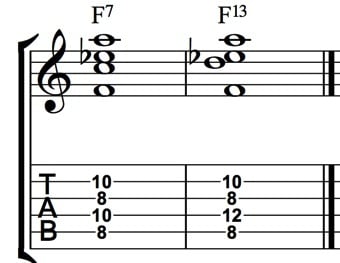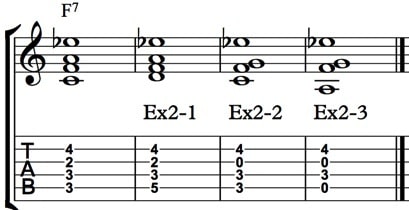
Don't Play That Chord
Nov 13, 2014Guest Post by Steve Raegele
Not All Chords Are Created Equal (So Don't Settle For Any Old Chord)
Lucid Dreaming by Steve Raegele

Welcome to this other installment of Steve's "Lucid Dreaming" article series on jazz guitar, improvisation and more ... today's article: taking boring chord shapes (don't play that chord, man!) and making them into something more personal. Steve, be my guest:
Along the way, many an aspiring guitarist has been instructed by many a well intentioned teacher that they need to learn their DROP 2 Voicings. I remember learning them for all the basic chord colours and doing them across the neck. The whole time, I remember thinking that something about them was just kind of "meh."
Root position C7 from the 5th string? (C, G, Bb, E, that is x3535x) Stinker! Completely devoid of inherent beauty.
Third inversion on the same string set? (G, C, E, Bb, that is x 10 10 9 11 x) Kill me. What a useless and cornball chord.
(2nd inversion is passable and could easily be trusted to drive alone in Dad's '66 Corvette. The rest of the lot need parental supervision ...)
Jazz Pedagogy Heresy
What am I getting at here? Don't learn my Drop 2 voicings? (I think I heard several archtop guitars drop to the floor and crack, their owners in disbelief at the jazz pedagogy heresy...) No. What I would like to remind you of, Ô Reader, is that one should never lose sight of your appreciation for the intrinsic quality of whatever material you are absorbing.
Learn your Drop 2 voicings. Then set about to customize them into something more personal and pleasing to your own tastes. The process of learning the basic Drop 2 system is quite valuable as a means to orient yourself to the geography of a chord. In fact, I quite like some of the voicings when articulated melodically.
Examples Please?!
One way to do this, is to begin substituting one or more pitches in a voicing until you have arrived at something that you feel has a vibe or resonance. In example 1, we see F7 in stock Drop 2 mode, followed by a simple alteration. We've jettisoned the C (our 5th-always a good candidate to walk the plank in an unaltered chord) and swooping in to add panache and flair is D (our 6th, or 13th). The voicing is immediately more pianistic and has some gravitas.

(I've always thought the unaltered version just sounds like bad wedding band shlock. But I digress...) The blueprint for the chord remains the Drop 2 shape you know and love, but it is by it's very nature outside of the box. The pinky stretch immediately forces you to start to expand the scope of what this sound world IS.
In Example 2, I take the process a little further. Using the 2nd inversion (C, F, A, Eb) as a starting point, I think we can all agree that this is a truly LAME chord. Don't use this chord. Ever. The first thing we'll do is follow the procedure from the last example and replace the fifth with the 6th again (Ex2-1).
Hmmm ... as an F7 chord, this might actually be even more lame. But I'm going to take note of it because it still has an interesting sonority. Let's bring the C back. Now let's try another angle. We'll lower our 3rd (A) to G, giving us the 2nd or 9th. That's a more appealing structure for me (Ex2-2).
Ambiguous, but colourful, and easily used as an F7 function. "But I'm missing the A", you say? Ok. Let's get rid of that C once and for all and throw the third down into the bass register to our open 5th string. This is sublime. It's inverted, colourful, and functional. What more could you want? (Ex2-3)

Try this process with as many chord tones as you like. Keep replacing chord tones with colour tones, chromatics, etc. until you arrive at voicings that you truly are inspired by. THEN try to find a way to justify them in a harmonic context. It can be a great supplement to the more systematic approach to fretboard harmony.
M-A Comments:
Inspiring ideas for aspiring guitarists. I've been doing that on my own for longer than I care to remember! Also see this article for ideas on re-voicing (and finding proper analytical reasoning for them).
Thank you Steve! See you next time.
Guest Post by Steve Raegele
Steve Raegele is a guitarist based in Montreal. He’s played many styles of music (except Bluegrass) in dozens of cities across 4 continents. He enjoys playing jazz, rock, R&B and improvising creative music. As a sideman Steve has played the music of Thom Gossage, Isaiah Ceccarelli, Nicole Lizée, Christine Jensen, and many others. His trio record, Last Century, is available from Songlines.









